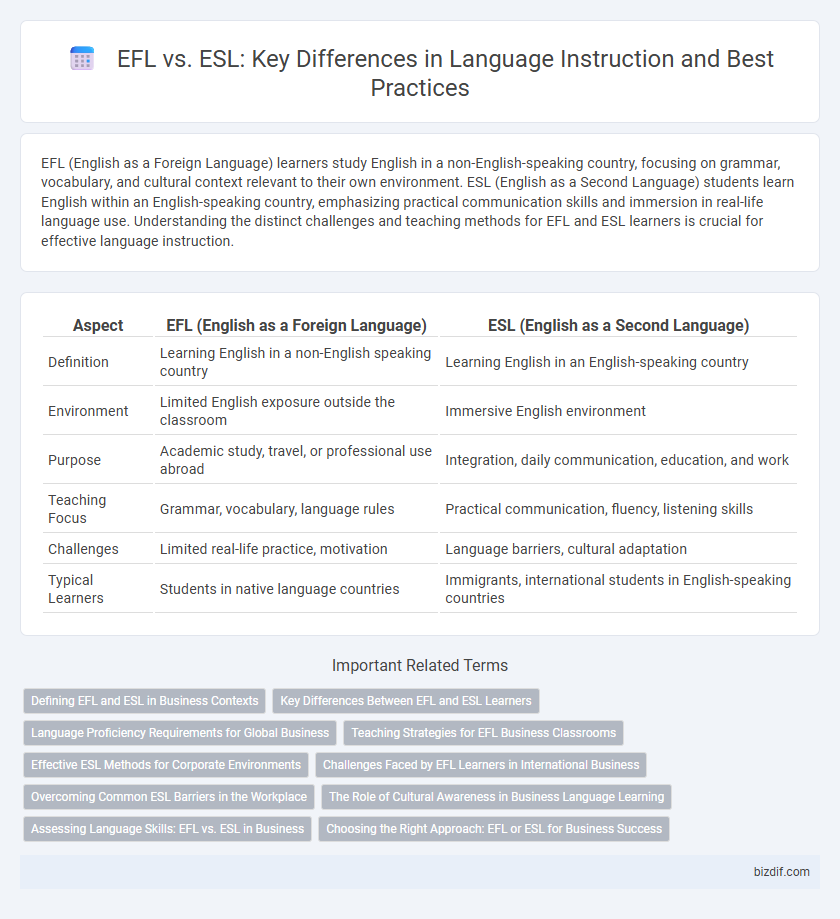EFL (English as a Foreign Language) learners study English in a non-English-speaking country, focusing on grammar, vocabulary, and cultural context relevant to their own environment. ESL (English as a Second Language) students learn English within an English-speaking country, emphasizing practical communication skills and immersion in real-life language use. Understanding the distinct challenges and teaching methods for EFL and ESL learners is crucial for effective language instruction.
Table of Comparison
| Aspect | EFL (English as a Foreign Language) | ESL (English as a Second Language) |
|---|---|---|
| Definition | Learning English in a non-English speaking country | Learning English in an English-speaking country |
| Environment | Limited English exposure outside the classroom | Immersive English environment |
| Purpose | Academic study, travel, or professional use abroad | Integration, daily communication, education, and work |
| Teaching Focus | Grammar, vocabulary, language rules | Practical communication, fluency, listening skills |
| Challenges | Limited real-life practice, motivation | Language barriers, cultural adaptation |
| Typical Learners | Students in native language countries | Immigrants, international students in English-speaking countries |
Defining EFL and ESL in Business Contexts
EFL (English as a Foreign Language) refers to teaching English to learners in countries where English is not the primary language, typically focusing on business vocabulary and communication skills relevant to international trade and corporate environments. ESL (English as a Second Language) involves instruction for individuals in English-speaking countries, emphasizing practical language usage for workplace integration and professional networking. Both approaches tailor language acquisition to enhance business interactions, negotiation tactics, and cross-cultural communication.
Key Differences Between EFL and ESL Learners
EFL (English as a Foreign Language) learners study English in non-English-speaking countries, primarily focusing on academic and written skills within a classroom setting, while ESL (English as a Second Language) learners acquire English in English-speaking environments, emphasizing practical communication and cultural integration. The exposure frequency to the English language differs significantly; ESL learners benefit from immersive daily interactions, whereas EFL learners have limited opportunities outside structured lessons. Motivation and learning goals also vary, with ESL learners often needing English for survival or work, and EFL learners driven by academic achievement or future career prospects.
Language Proficiency Requirements for Global Business
EFL (English as a Foreign Language) learners often need tailored language proficiency requirements to meet specific global business contexts, emphasizing advanced vocabulary and cultural nuances for international trade and negotiation. ESL (English as a Second Language) learners typically require comprehensive language skills, including fluency in speaking and comprehension, to function effectively in domestic and multinational business environments. Both EFL and ESL programs prioritize proficiency benchmarks such as TOEFL, IELTS, and CEFR levels to ensure learners achieve the communication standards essential for global business success.
Teaching Strategies for EFL Business Classrooms
Teaching strategies for EFL business classrooms emphasize context-specific vocabulary, role-playing, and real-life simulations to enhance language acquisition. Instructors incorporate case studies, business negotiations, and presentation practices to develop both linguistic competence and professional communication skills. Cultural awareness and industry-specific terminology are integrated to prepare learners for global business environments effectively.
Effective ESL Methods for Corporate Environments
Effective ESL methods for corporate environments prioritize immersive communication techniques and practical language use tailored to industry-specific contexts. Integrating role-play scenarios, collaborative projects, and technology-based learning platforms enhances employee engagement and retention of essential business English skills. Emphasizing cultural competence alongside language proficiency supports smoother international collaboration and stronger workplace relationships.
Challenges Faced by EFL Learners in International Business
EFL learners in international business often struggle with limited exposure to English outside the classroom, resulting in weaker conversational fluency and cultural nuances compared to ESL counterparts. They face difficulties understanding idiomatic expressions, industry-specific jargon, and varying accents, which impedes effective communication in global trade negotiations. These challenges frequently lead to misunderstandings, reduced confidence in communication, and slower integration into multinational business environments.
Overcoming Common ESL Barriers in the Workplace
Overcoming common ESL barriers in the workplace involves addressing language proficiency challenges, cultural misunderstandings, and communication gaps that hinder effective collaboration. Employers can implement targeted language training, mentorship programs, and inclusive communication strategies to support ESL employees in improving workplace interactions. Enhanced ESL support not only boosts employee confidence but also increases productivity and fosters a more inclusive organizational culture.
The Role of Cultural Awareness in Business Language Learning
Cultural awareness plays a crucial role in both EFL (English as a Foreign Language) and ESL (English as a Second Language) business language learning by enhancing communication effectiveness and reducing misunderstandings in multicultural environments. EFL learners, often operating outside English-speaking countries, benefit from cultural insights to navigate international business etiquette, while ESL learners, typically immersed in English-speaking regions, require cultural competence to integrate and collaborate within local corporate settings. Integrating cultural awareness into language instruction fosters pragmatic skills essential for negotiation, presentation, and networking in global business contexts.
Assessing Language Skills: EFL vs. ESL in Business
Assessing language skills in EFL (English as a Foreign Language) contexts focuses on measuring learners' ability to use English primarily in academic or international business environments, where exposure to English outside the classroom is limited. ESL (English as a Second Language) assessment emphasizes practical communication skills within immersive environments, often targeting workplace interactions and cultural integration. Business language assessments for both EFL and ESL learners prioritize proficiency in professional vocabulary, listening comprehension in meetings, and effective written communication, tailored to the unique linguistic challenges faced in global commerce.
Choosing the Right Approach: EFL or ESL for Business Success
Selecting the right language instruction approach, EFL (English as a Foreign Language) or ESL (English as a Second Language), depends on the learner's environment and business objectives. EFL suits individuals learning English in non-English-speaking countries, emphasizing formal language skills for global business communication, while ESL targets those in English-dominant settings, focusing on practical language use for workplace integration. Understanding these distinctions helps organizations design effective training programs that enhance employee communication and drive business success.
EFL vs ESL Infographic

 bizdif.com
bizdif.com